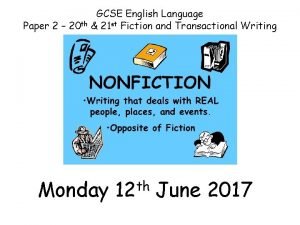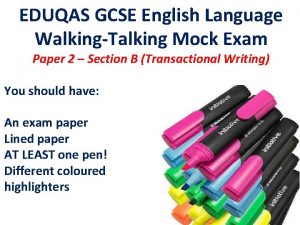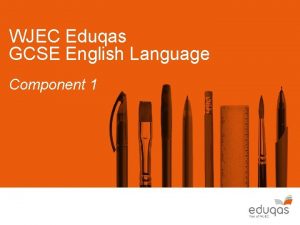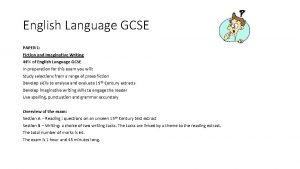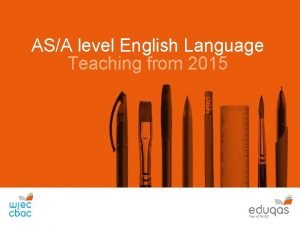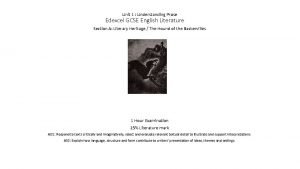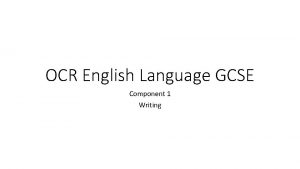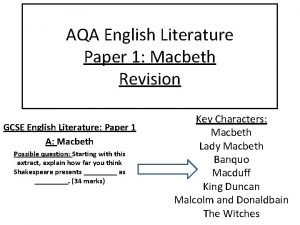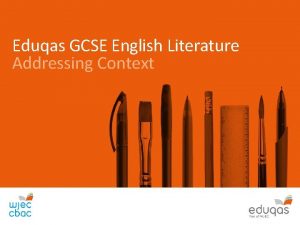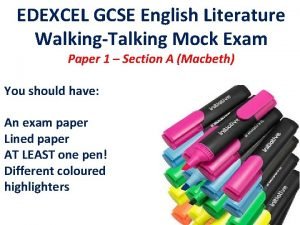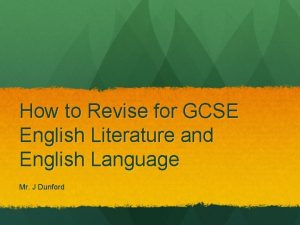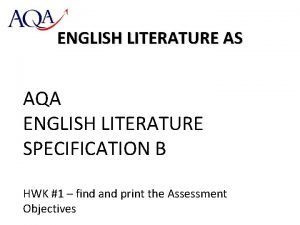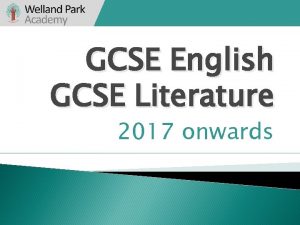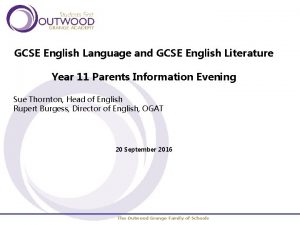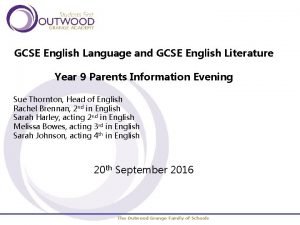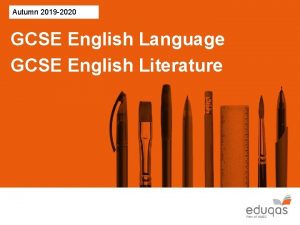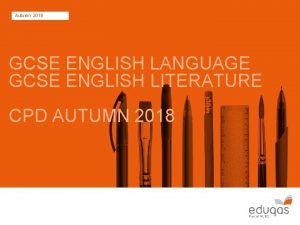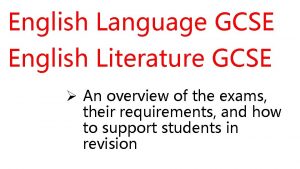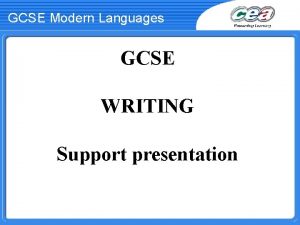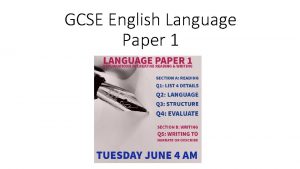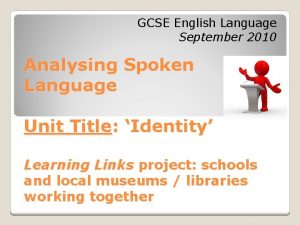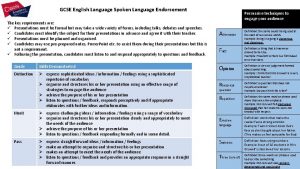Welcome to English GCSE English Language How you





















- Slides: 21

Welcome to English GCSE English Language How you can support your child

Question 1 • 8 marks • 12 minutes • Inference and deduction (read between the lines for meaning)

Question 1 Read Source 1, ‘With friends like these…’ by Tom Hodgkinson. 1 From reading the article, what do you understand about the issues the writer has with Facebook?

Question 1

Examiner’s Report The most successful answers offered both detailed understanding and perceptive interpretations, for example that the competitive nature of friendship and self-vanity is unhealthy and detrimental. Noting that Hodgkinson was intending to ‘retreat from the whole thing’ was generally understood with, again, the best responses offering a rationale for that decision. The question required retrieval and interpretation and the small but significant number of candidates who variously analysed the writer’s use of language, argued with the writer’s standpoint or otherwise made a critique of the article were not rewarded for so doing.

Question 2 Now read Source 2, ‘Festival fans defy elements to revel in the Isle of Mud’ by Kaya Burgess. 2 Explain how the headline and picture are effective and how they link to the text.

Question 2

Examiner’s Report • However, few developed this recognition into an analysis or into a perceptive observation about the effect of this device on the reader. Comments about the density and colour of the tents and the gestures of the young men in the picture were usually clear and offered sufficient interpretation for a mark in Band 3; but few pushed beyond this. Less successful responses offered only generalised effects such as stating that the headline ‘makes you want to find out more’, or that the picture ‘puts an image in your head’. A number of candidates, as in previous series, linked the headline with the picture which, except where the comments showed enhanced understanding of each, was not a requirement of the question.

Model Paragraph Students should aim to write 3 to 4 PEE paragraphs. They should spend 12 minutes on this question. Here is an example of one: The verb choice ‘defy’ in the headline is powerful because it suggests to the reader that the people were determined to stay at the festival even though the muddy conditions were dreadful. This effectively links to the text when it describes the mud as ‘like gravy’ which is further supported by the picture which shows people happily camping and defying the elements amongst the ‘gravy’ mud. EVIDENCE

Question 3 Now read Source 3, ‘Stranded on Vanuatu’, which is an extract from a non-fiction book. 3 Explain some of the thoughts and feelings the writer has whilst he is on the island.

Question 3

Examiner’s Report Question 3 The abundance of thoughts and feelings expressed by the writer in the source text for this question meant that almost 60% of candidates were able to achieve a mark of 5 or better. That the writer felt stifled, hot, uncomfortable and irritated were feelings universally acknowledged, and candidates were, on the whole, able to explain those feelings and support them from the text. Similarly, Peters’ feeling of abandonment and distress at being lost were clearly articulated. More successful responses presented more subtle changes in feelings, explaining, for example, the juxtaposition of thoughts and feelings regarding the setting sun’s ‘tantrum of citrus hues’ and the ‘dense hostile darkness’ which followed; or the joyful feelings when remembering ‘leafy suburbs’ and the ‘abject abandonment’ described soon after. Some candidates might have benefitted from a more careful reading of parts of the text so that the writer’s feelings about the kerosene lamps, for example, and the ‘ring of coral’ would then have become more clear. For a few candidates, a grasp of the piece was less apparent : that Peters was hungry, was considering suicide, was neglected as a child and never saw his parents again after the incident in the department store, were interpretations which perhaps called for more considered reading. As with Question 1, a small number of candidates wrote about the linguistic or narrative effectiveness of the piece, and some about the thoughts and feelings experienced by the reader whilst reading the text. Such responses were not rewarded, being, as they were, not part of the question.

Question 4 Now you need to refer to Source 3, ‘Stranded on Vanuatu’, and either Source 1 or Source 2. You are going to compare the use of language in two texts, one of which you have chosen. 4. Compare the ways in which language is used for effect in the two texts. Give some examples and analyse what the effects are.

Question 4

Examiner’s Report About 60% of candidates achieved marks in Band 2 for their responses to this question, and fewer than 23% reached Band 3 or above. This has been the pattern for every series so far. Candidates included comments and observations about purpose, audience, length of sentences and content in Source 3 and their chosen source, none of which gained any marks because none is relevant to the question set. Indeed, it was noticeable that in some cases, mnemonics, written at the beginning of the answer, actually guided those candidates onto an erroneous path. Candidates who selected judiciously from the abundance of linguistic features in Source 3 and the other, chosen text often made generalised, vague or simple comments in an attempt to analyse. Candidates who reached Band 3, at the lower end, often achieved their mark by suggesting a clear effect at least on devices such as lists, facts, alliteration etc. Few candidates engaged in an analytical way with the wealth of imagery and vivid descriptive language choices available to them.

Question 5 A website called The Best and the Worst is asking for contributions. Write an entry for it which describes the best meal you ever had and the worst. Explain the reasons for your choices. Audience – who could this be? Genre Purpose

Question 5

Examiner’s Report The topic for Question 5; the best and the worst meal, was well received. Candidates evidently enjoyed writing about it and examiners enjoyed marking it. The task was accessible and candidates had plenty to say, some showing considerable knowledge and understanding of culinary matters and associated vocabulary. The less successful writing focused entirely on the food aspect of the meal which, in some cases, resulted in the over-use of both cliché and hyperbole. The most successful considered context: the restaurant décor; the attitude of the waiters or the harmonious – or otherwise – circumstances of a family occasion, and some produced restaurant critiques or humorous travelogue-style responses. The best responses combined lively and controlled writing with an original, perhaps ironic approach relating the meal to wider, even perhaps ethical considerations.

Question 6 There is evidence that many young people are not eating, exercising or spending their leisure time properly and that this is damaging their health and life chances. Write an article for Living Today magazine which persuades young people to improve their diet and lifestyle. Purpose Genre Audience

Question 6

Examiner’s Report Candidates responded well to the topic in Question 6, which was within their personal experience and about which they had a view. A number borrowed ideas freely, and successfully, from Source 2 and many employed facts and statistics, although the sometimes spurious or unrealistic nature of these was detrimental to the effectiveness of the writing. Often candidates took a utilitarian approach to their writing by assuming that their readers were stereotypically fast food and computer game addicts and, by adopting an appropriately persuasive tone, encouraged them to participate in a variety of health and exercise options, whilst at the same time easing the burden by exercising with friends or joining a gym to make it more sociable and fun. A more successful approach employed humour, irony or satire in order to manipulate, whilst simultaneously entertaining, the reader. Candidates who included wider, perhaps more moral or social aspects of personal responsibility or well-being in their writing were likely to be considered convincing. More than 78% of candidates achieved a mark in Band 3 or above for communication of ideas and more than 75% achieved a mark of 5 or better out of 8 for accuracy, suggesting that sentence structure, punctuation and spelling were generally secure. Many of the responses to both Question 5 and Question 6 were lengthy. Whereas this suggests that candidates had enough time to complete the paper and is, therefore, a positive indicator, length of answer did not, of itself, earn candidates more marks; focus, poignancy and succinctness, on the other hand, did.
 Pearson english language
Pearson english language Edexcel gcse english language paper 2
Edexcel gcse english language paper 2 Edexcel english literature paper 1 past papers
Edexcel english literature paper 1 past papers Eduqas english language gcse past papers
Eduqas english language gcse past papers Eduqas gcse english language past papers
Eduqas gcse english language past papers Eduqas english language component 1
Eduqas english language component 1 The lovely bones language paper 1 answers
The lovely bones language paper 1 answers English fiction and imaginative writing
English fiction and imaginative writing Welcome welcome this is our christmas story
Welcome welcome this is our christmas story A level english language language change
A level english language language change Edexcel gcse english literature
Edexcel gcse english literature Ocr english literature gcse
Ocr english literature gcse English literature paper 1 macbeth and inspector calls
English literature paper 1 macbeth and inspector calls Unseen poetry eduqas
Unseen poetry eduqas Macbeth revision edexcel
Macbeth revision edexcel Soundcloud download
Soundcloud download Bedford gcse english
Bedford gcse english Pearson edexcel international gcse english anthology
Pearson edexcel international gcse english anthology Aqa english literature specification
Aqa english literature specification Edexcel inspector calls exam questions
Edexcel inspector calls exam questions Do you love the rain
Do you love the rain Agree or disagree questions about life
Agree or disagree questions about life

